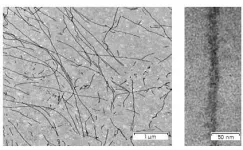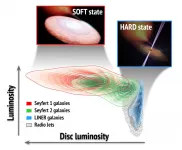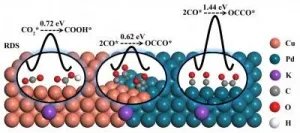(Press-News.org) HOUSTON - Researchers at The University of Texas MD Anderson Cancer Center have discovered a novel function for the metabolic enzyme medium-chain acyl-CoA dehydrogenase (MCAD) in glioblastoma (GBM). MCAD prevents toxic lipid buildup, in addition to its normal role in energy production, so targeting MCAD causes irreversible damage and cell death specifically in cancer cells.
The study was published today in Cancer Discovery, a journal of the American Association for Cancer Research. Preclinical findings reveal an important new understanding of metabolism in GBM and support the development of MCAD inhibitors as a novel treatment strategy. The researchers currently are working to develop targeted therapies against the enzyme.
"With altered metabolism being a key feature of glioblastoma, we wanted to better understand these processes and identify therapeutic targets that could have real impact for patients," said lead author Francesca Puca, Ph.D., instructor of Genomic Medicine. "We discovered that glioblastoma cells rely on MCAD to detoxify and protect themselves from the accumulation of toxic byproducts of fatty acid metabolism. Inhibiting MCAD appears to be both potent and specific in killing glioblastoma cells."
To uncover metabolic genes that are key to GBM survival, the research team performed a functional genomic screen in a unique preclinical model system that permitted an in vivo study using patient-derived GBM cells. After analyzing 330 metabolism genes in this model, they discovered that several enzymes involved in fatty acid metabolism were important for GBM cells.
The team focused on MCAD because it was identified in multiple GBM models and found at high levels in GBM cells relative to normal brain tissue. In-depth studies determined that blocking MCAD in GBM cells resulted in severe mitochondrial failure caused by the toxic buildup of fatty acids, which normally are degraded by MCAD.
This resulted in a catastrophic and irreversible cascade of events from which GBM cells could not recover, explained senior author Andrea Viale, M.D., assistant professor of Genomic Medicine.
"It appears that the downregulation of this enzyme triggers a series of events that are irreversible, and the cells are poisoned from the inside," Viale said. "Usually, tumor cells are able to adapt to treatments over time, but, based on our observations, we think it would be very difficult for these cells to develop resistance to MCAD depletion."
While blocking MCAD appears to be detrimental to the survival of GBM cells, the research team repeatedly found that normal cells in the brain were not affected by loss of the enzyme, suggesting that targeting MCAD could be selective in killing only cancer cells. Supporting this observation is the fact that children and animals born with an MCAD deficiency are able to live normally with an altered diet.
"It has become clear that MCAD is a key vulnerability unique to glioblastoma, providing us a novel therapeutic window that may eliminate cancer cells while sparing normal cells," said senior author Giulio Draetta, M.D., Ph.D., chief scientific officer and professor of Genomic Medicine. "We are looking for discoveries that will have significant benefits to our patients, and so we are encouraged by the potential of these findings. We are actively working to develop targeted therapies that we hope will one day provide an effective option for patients."
The research team has characterized the three-dimensional structure of the MCAD protein in a complex with novel small molecules designed to block the activity of the enzyme. As promising drug candidates are discovered, the researchers will work in collaboration with MD Anderson's Therapeutics Discovery division to study these drugs and advance them toward clinical trials.
INFORMATION:
A full list of collaborating authors and their disclosures can be found here. The research was supported by the National Cancer Institute (NCI) (R01 CA218139 01 A1, R37CA237421, R01CA248160, R01CA244931, P30CA046592, 2P50CA127001, DK097153, CA16672, P30CA16672), the Sewell Family Chair in Genomic Medicine, the Cancer Prevention & Research Institute of Texas (CPRIT) (RP140672, RP150519, RP170067), the CPRIT Graduate Scholar Program, the American-Italian Cancer Foundation, MD Anderson's Moon Shots Program®, the Broach Foundation for Brain Cancer Research, the Howard and Susan Elias Foundation, the Charles Woodson Clinical Research Fund and the University of Michigan Pediatric Brain Tumor Research Initiative.
Alzheimer's disease is the most common neurodegenerative disorder in which neurons gradually die off, leading to dementia. The exact mechanism and causes of this disorder have not yet been identified. However, it is known that amyloid plaques form in the brains of patients. Plaques consist of amyloid fibrils, which are special filamentous assemblies formed by amyloid proteins.
'The number of patients with neurodegenerative disorders will continue to grow in the future. Thanks to the success of humanity in the treatment of cancer and cardiovascular diseases, more and more people are living into their 80s. At this age, the risk of developing neurodegenerative disorders, including Alzheimer's disease, becomes very high. Unfortunately, no cures for these diseases have yet ...
Killer flies can reach accelerations of over 3g when aerial diving to catch their prey - but at such high speeds they often miss because they can't correct their course.
These are the findings of a study by researchers at the Universities of Cambridge, Lincoln, and Minnesota, published today in the Journal of the Royal Society Interface.
Killer flies (Coenosia attenuata) perform high-speed aerial dives to attack prey flying beneath them, reaching impressive accelerations of up to 36 m/s2, equivalent to 3.6 times the acceleration due to gravity (or 3.6g). This happens because they beat their wings as they fall, combining the acceleration of powered flight with the acceleration of gravity.
This is an impressive feat: diving Falcons, the fastest animals that predate ...
The researchers Juan A. Fernández-Ontiveros, of the Istituto Nazionale di Astrofisica (INAF) in Rome and Teo Muñoz-Darias, of the Instituto de Astrofísica de Canarias (IAC), have written an article in which they describe the different states of activity of a large sample of supermassive black holes in the centres of galaxies. They have classified them using the behaviour of their closest "relations", the stellar mass black holes in X-ray binaries. The article has just been published in the journal Monthly Notices of the Royal Astronomical Society (MNRAS).
Black holes range in mass from objects which have only a few ...
Mercury pollution is an issue of global concern due to its toxic effects. High levels have already been measured in Arctic organisms - with worrying effects on ecosystems and the food chain. So far, the Greenland Ice Sheet has not been taken into account as a part of the Arctic mercury cycle. Now, researchers led by Jon Hawkings of the German Research Centre for Geosciences in Potsdam and Florida State University show that meltwaters in the southwest of Greenland transport considerable amounts of mercury into the Arctic Ocean. Due to the large quantities detected, the researchers assume that they are of geological origin. They present their measurements in the current issue of Nature Geoscience.
Mercury: poison for humans and the environment - ...
LAWRENCE -- For two weeks in June 2020, a massive dust plume from Saharan Africa crept westward across the Atlantic, blanketing the Caribbean and Gulf Coast states in the U.S. The dust storm was so strong, it earned the nickname "Godzilla."
Now, researchers from the University of Kansas have published a new study in the Bulletin of the American Meteorological Society parsing the mechanism that transported the dust. Their results explain a phenomenon that could occur more frequently in the years ahead due to climate change, affecting human health and transportation systems.
African dust darkened the skies of the Caribbean and American Gulf States thanks to a trio of atmospheric patterns, ...
Mitochondria are the cell's power plants and produce the majority of a cell's energy needs through an electrochemical process called electron transport chain coupled to another process known as oxidative phosphorylation. A number of different proteins in mitochondria facilitate these processes, but it's not fully understood how these proteins are arranged inside mitochondria and the factors that can influence their arrangement.
Now, scientists at the University of Copenhagen have used state-of-the-art proteomics technology to shine new light on how mitochondrial proteins gather into electron transport chain complexes, and further into so-called supercomplexes. The research, which is published in Cell Reports, also examined ...
Over the years, robots have gotten quite good at identifying objects -- as long as they're out in the open.
Discerning buried items in granular material like sand is a taller order. To do that, a robot would need fingers that were slender enough to penetrate the sand, mobile enough to wriggle free when sand grains jam, and sensitive enough to feel the detailed shape of the buried object.
MIT researchers have now designed a sharp-tipped robot finger equipped with tactile sensing to meet the challenge of identifying buried objects. In experiments, the aptly named ...
A mathematical model which can predict landslides that occur unexpectantly has been developed by two University of Melbourne scientists, with colleagues from GroundProbe-Orica and the University of Florence.
Professors Antoinette Tordesillas and Robin Batterham led the work over five years to develop and test the model SSSAFE (Spatiotemporal Slope Stability Analytics for Failure Estimation), which analyses slope stability over time to predict where and when a landslide or avalanche is likely to occur.
In a study published in Scientific Reports, the research team was ...
Discovered by Victor Hess in 1912, cosmic rays, relativisitic particles that shower Earth, contribute a signicant part of the energy density in the universe and carries unambiguous informations on various astrophysical processes . Yet until now, origin of cosmic rays is still a mystery.
A key problem in understanding the origin of cosmic rays is the searching for the acceleration site up to or even beyond Ultra-high energy (UHE). Such extreme accelerators are dubbed as PeVatrons. However, composed of subatomic particles, such as protons or atomic nuclei, cosmic rays are charged and lose ...
Using intermittent electric energy to convert excessive CO2 into C2 products, such as ethylene and ethanol, is an effective strategy to mitigate the greenhouse effect. Copper (Cu) is the only single metal catalyst which can converts CO2 into C2 products by electrochemical method, but with undesirable selectivity of C2 product. Therefore, how to improve the conversion efficiency of Cu-based catalysts for reducing CO2 to C2 product has attracted great attention.
Recently, a research team led by Prof. Min Liu from Central South University, China designed a Cu-Pd bimetallic electrocatalyst possessing CuPd(100) interface which can lower the energy barrier of C2 product generation. The electrocatalyst was obtained through using ...







